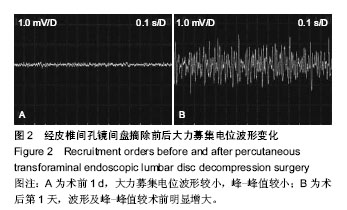| [1] Battie MC, Videman T, Parent E. Lumbar disc degeneration: epidemiology and genetic influences. Spine (Phila Pa 1976). 2004;29(23):2679-2690.
[2] Choi YS. Pathophysiology of degenerative disc disease. Asian Spine J. 2009;3(1):39-44.
[3] Quint U, Wilke HJ. Grading of degenerative disk disease and functional impairment: imaging versus patho-anatomical findings. Eur Spine J. 2008;17(12):1705-1713.
[4] 朱泽章,邱勇,王斌,等.以脊柱侧凸为首发症状的青少年不典型腰椎间盘突出症诊治分析[J].中华外科杂志, 2008, 46(14):1058-1061.
[5] Suzuki H, Endo K, Kobayashi H, et al. Total sagittal spinal alignment in patients with lumbar canal stenosis accompanied by intermittent claudication. Spine (Phila Pa 1976). 2010; 35(9): E344-346.
[6] Endo K, Suzuki H, Tanaka H, et al. Sagittal spinal alignment in patients with lumbar disc herniation. Eur Spine J. 2010;19(3): 435-438.
[7] 高庆,方诗元.肌电图评价腰椎间盘突出症的临床价值[J].中国组织工程研究与临床康复,2011,15(13):2438-2441.
[8] 余洪俊,刘宏亮,陈蕾.表面肌电图的发展与应用[J].中国临床康复, 2002,6(5):720-721.
[9] 吴文,黄国志,刘湘江.表面肌电图用于腰椎间盘突出症疗效评定的研究[J].中华物理医学与康复杂志, 2002,24(9):42-44.
[10] Suk KS, Lee HM, Moon SH, et al. Lumbosacral scoliotic list by lumbar disc herniation. Spine (Phila Pa 1976). 2001;26(6): 667-671.
[11] Matsui H, Ohmori K, Kanamori M, et al. Significance of sciatic scoliotic list in operated patients with lumbar disc herniation. Spine (Phila Pa 1976). 1998;23(3):338-342.
[12] Lorio MP, Bernstein AJ, Simmons EH. Sciatic spinal deformity-lumbosacral list: an "unusual" presentation with review of the literature. J Spinal Disord. 1995;8(3):201-205.
[13] Harrison DE, Harrison DD, Cailliet R, et al. Radiographic analysis of lumbar lordosis: centroid, Cobb, TRALL, and Harrison posterior tangent methods. Spine (Phila Pa 1976). 2001;26(11):E235-242.
[14] 邹漳钰,周瑞玲,季晓林,等.不同阶段肌萎缩侧索硬化患者肌电图的研究[J].临床神经病学杂志,2006,19(1):4-7.
[15] Edwards CC, 2nd, Lenke LG, Peelle M, et al. Selective thoracic fusion for adolescent idiopathic scoliosis with C modifier lumbar curves: 2- to 16-year radiographic and clinical results. Spine (Phila Pa 1976). 2004;29(5):536-546.
[16] Puno RM, An KC, Puno RL, et al. Treatment recommendations for idiopathic scoliosis: an assessment of the Lenke classification. Spine (Phila Pa 1976). 2003;28(18): 2102-2114; discussion 2114-2105.
[17] 刘绮,麦明泉,肖灵君,等.中文版Oswestry功能障碍指数评定慢性腰痛患者的反应度研究[J].中国康复医学杂志,2010,25(7): 621-624.
[18] 郑光新,赵晓鸥,刘广林,等.Oswestry功能障碍指数评定腰痛患者的可信性[J].中国脊柱脊髓杂志,2002,12(1):13-15.
[19] Finneson BE.Low Back Pain.Philadelphia JB Lippincott, 1973: 290-303.
[20] Cheung J, Halbertsma JP, Veldhuizen AG, et al. A preliminary study on electromyographic analysis of the paraspinal musculature in idiopathic scoliosis. Eur Spine J. 2005;14(2): 130-137.
[21] Gaudreault N, Arsenault AB, Lariviere C, et al. Assessment of the paraspinal muscles of subjects presenting an idiopathic scoliosis: an EMG pilot study. BMC Musculoskelet Disord. 2005;6:14.
[22] Lu WW, Hu Y, Luk KD, et al. Paraspinal muscle activities of patients with scoliosis after spine fusion: an electromyographic study. Spine (Phila Pa 1976). 2002;27(11):1180-1185.
[23] 蒋毅,宋华伟,王东.微创椎间孔镜治疗伴有坐骨神经痛的腰椎间盘突出症[J].中国骨伤,2013,26(10):800-804. |


.jpg)